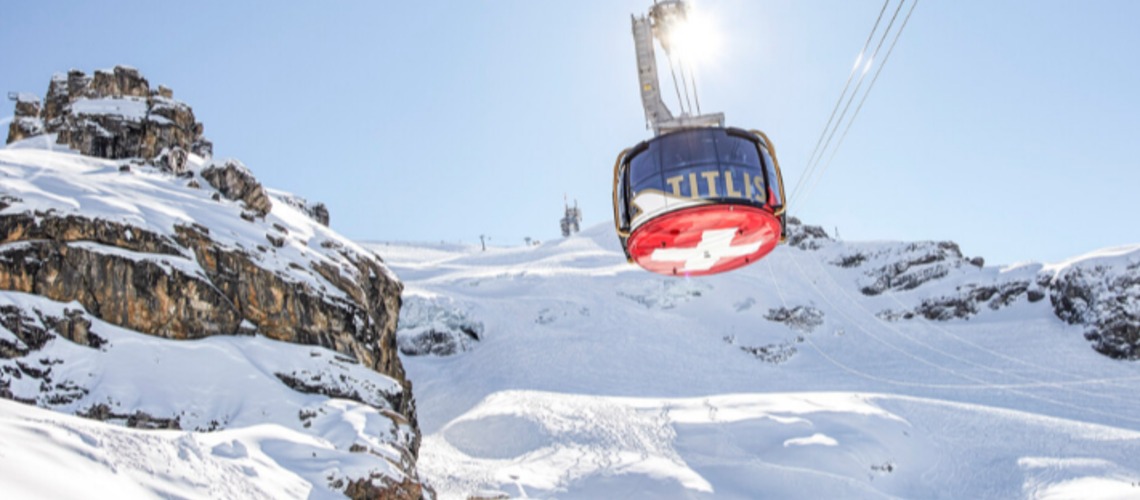Feasibility Study Is Available On Titlis, Melchsee-Frutt, Hasliberg Connection

The feasibility study for cooperation between the three tourism regions of Engelberg-Titlis, Melchsee-Frutt and Meiringen-Hasliberg has been prepared as part of an intercantonal project of the New Regional Policy (NRP). The final report shows that a physical connection between the regions would be feasible, but also makes well-founded statements about their profitability, environmental compatibility and the effects on the traffic situation.
In 2018, the cantons of Obwalden, Nidwalden and Bern, together with Bergbahnen Engelberg-Titlis AG, Sportbahnen Melchsee-Frutt and Bergbahnen Meiringen-Hasliberg AG, conducted a feasibility study for a possible joint further development of the three tourism regions initiated. The project committee responsible for the feasibility study, in which representatives of the three cantons involved and the railway companies concerned participated, was headed by Obwalden Landammann Daniel Wyler.
Central findings in the final report
The present feasibility study shows that a physical connection of the three tourist areas would be technically possible in principle. However, this could be realized between Melchsee-Frutt and Meiringen-Hasliberg much more easily and cost-effectively than in the direction of Engelberg-Titlis. The estimated total costs are between around 50 and 70 million francs, depending on the variant chosen. Based on the findings of the study, a connection would in particular lead to an increase in the length of stay of the guests in winter. Accordingly, additional local added value could be expected. The profitability calculation only takes into account the additional traffic revenue of the mountain railways and results in a rather tight profitability. Accordingly, a connection between the three areas would only pay off if if additional warm beds are made available in all three regions or cold beds are converted into warm ones, thus generating additional overnight stays. In addition, the cheaper variant would have to be built.
The investigation of the effects on nature and landscape show that the tested connection variants would be visible and would mean an intervention in nature. However, if implemented on site, these interventions could be compensated for by upgrading the living space in the immediate vicinity. The traffic analysis has shown that the desired increase in ski days would have little impact on the traffic situation. With suitable measures identified in the traffic analysis, an attempt should be made to achieve a shift to public transport.
With suitable measures identified in the traffic analysis, an attempt should be made to achieve a shift to public transport. However, if implemented on site, these interventions could be compensated for by upgrading the living space in the immediate vicinity. The traffic analysis has shown that the desired increase in ski days would have little impact on the traffic situation. With suitable measures identified in the traffic analysis, an attempt should be made to achieve a shift to public transport.
Consensus building process and networking
The aim of the feasibility study was also to initiate a consensus-building process between the various interest groups. At the beginning of the work, the environmental organizations and interest groups active in the area were invited to receive information in support groups. Most organizations accepted this offer. You have been informed periodically.
The key people from the three mountain railways involved were represented in the committee and the “Economy, Market and Products” commission. The discussions held in these bodies have contributed to a better understanding for one another. "The members of the commissions have done a good job. Our thanks also go primarily to the three mountain railways. Their internal experts have contributed a lot to the fact that the reports could be drawn up on the basis of concrete facts and figures," emphasizes Landammann Daniel Wyler.
Development potential
The Obwalden Government Council notes that the reports provide a well-founded analysis and differentiated figures for the opportunities for further development. The reports still focus heavily on winter tourism due to the experience gained from connections with other ski areas and the expected purchasing power of the guests. The reports also show, however, that the number of summer guests is increasing in all three areas and that there is a trend away from skiing guests. Against the background of climate change and its risks, the government council sees a lot of future potential in year-round tourism.
The three railways decide how to proceed
The NRP project is completed with the final report of the feasibility study. Whether specific projects will be pursued is now up to the entrepreneurial decision of the three mountain railways involved.














